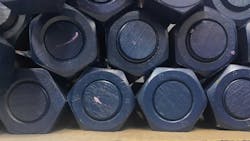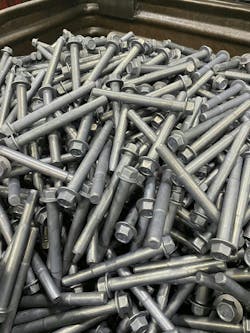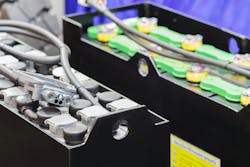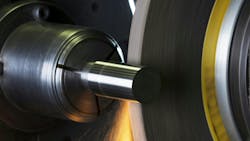Push to Electrification Requires a Rethinking of Fastener Technology
As manufacturers look to the future and how electric motors will factor into trucks, heavy equipment, and other electric vehicles, they are asking fastener manufacturers to re-think and innovate how fastener technology will need to be developed and used in future machines.
The dynamics, properties, design, and manufacturing of electric vehicles present a host of new challenges to fastener technology providers. Such things as the need to lower the overall weight of vehicles, the shift away from traditional heavy metal-based materials, or dynamic changes in manufacturing and assembly techniques are making, and will make, fastener manufacturers explore a variety of solutions to remain relevant to the fluid power and electric motion control sector.
Commonalities Exist Between Electric- and Engine-Based Powertrains
Let’s look at the history and comparisons of electric and other powertrains, and how that may be a precursor to the future.
Surprisingly, both combustion engine technology and electrification have a number of similarities. Uniformly, history will serve that both combustion engines and electrification were each transformative for their time. They enabled new levels of productivity for power transmission, vehicles, and machines and changed the course of mobility and work.
One example is inventor Rudolf Diesel's combination of energy density of the fuel and efficiency of the combustion cycle which led to the creation of the most energy efficient internal combustion engine.
While not energy dense, storage of electrical energy in batteries and its use to directly drive electric motors opened new opportunities that for the first time were not rooted in the internal combustion engine nor liquid fuel power transmission.
Both combustion engine and electric technology are controversial, in large part because of the fuels that power them. For diesel and gas engines, there is the issue of using fossil fuels and how they are extracted and refined. Electric systems, on the other hand, have issues related to extraction of rare earth metals mined largely from third-world countries.
Both combustion engines and electric powertrains can source fuels from different kinds of energy such as solar, wind, fossil fuels for generating electric power, and petroleum or renewable biofuels for powering combustion engine-based powertrains.
History will show the arc of renewable fuels first used in Diesel's initial demonstration of his compression ignition engine (fueled by peanut oil in Paris at the Paris Exposition of 1900) to a time when the use of renewable fuels rapidly evolved as mainstream low-carbon fuels that ensured combustion engine's, such as Diesel's, could be included as a solution for reducing greenhouse gas (GHG) emissions and tackling global climate change.
So, it is altogether fitting that they are now coming together to offer more advanced, pliable powertrain solutions for all sorts of applications traditionally supported solely with compression ignition engine technology. And fasteners are playing a big role in that transition.
READ MORE: Revenue Potential Increasing for Electric Truck Powertrain Components
Rethinking Fastener Designs is Necessary for Electric Vehicles
Fasteners make up a significant number of SKUs in a powertrain, including combustible engines and associated power systems. So, there is no question they are an important element of any new powertrain.
With the introduction of electrification into the vehicle world comes the need to reassess conventional fastener designs. With new advances in technology such as electric and/or hybrid powered vehicles, fastener makers are rethinking, refining, re-engineering and often reinventing fasteners to meet the needs of powertrain manufacturers and address the peculiarities of design, manufacturing, and assembly of electric and hybrid systems.
Perhaps the biggest issues regarding fasteners are potential chemical corrosion, torque, and metal stress.
Chemical corrosion has been an issue with almost any part going into larger machines, but with the introduction of battery technology, corrosion takes on a different set of challenges. The close proximity of fasteners to the batteries and fasteners that may be holding the battery technology in place has to be taken into consideration when choosing fastener technology.
Lighter weight materials are being used for components to reduce the overall weight of electric vehicles due to the additional weight of the batteries. This is causing a shift toward aluminum, magnesium, and plastic. However, aluminum, magnesium, and plastic do not allow for welding (weld nuts, weld studs, thin metal assembly welding, etc.). Also, aluminum is a lower strength material relative to the common steel components currently being used. That presents problems too in terms of strength and stability.
In addition, the electro-static charges of the metal compounds used in fasteners vary and need to be taken into consideration when designing electric-powered vehicles or machines.
Clamp loads become a factor as well, particularly when battery technology is heavy and often plastic fasteners are substituted in some applications. The science behind different torque loads and torque technology then becomes a major design factor.
The sheer power output of electric powertrains where full torque can be realized in a split second puts a lot of pressure on the fasteners holding the system in place, requiring a new way of thinking about part stress and the flexibility needed to allow a “give and take” on the materials whereby they do not fail under pressure.
Also, the move from combustion engine technology to electric motors greatly simplifies manufacturing and assembly which allows for fewer and less complex components for simpler fastener connections, allowing for more use of standardized fastening systems.
Battery-driven powertrains require more precise tooling of the fastener in the manufacturing process as well, given all the different specifications of the design of hybrid and/or electric vehicles. The quality of manufacturing then becomes a big factor and the right supplier has to be vetted to ensure the levels of quality desired are achieved.
READ MORE: System-Level Analysis Key for Transition to Electrification
New Fastener Technology Offers Numerous Benefits to Electric Powertrain Makers
All-in-all, the move from traditional engines to hybrid and electric powertrains is changing how manufacturers of these technologies need to think about fasteners. But, with this new thinking, the industry will realize a host of benefits overall.
First of all, there are fewer moving parts in electric-based powertrains and less complexity means an opportunity to reduce the number of fasteners used. This may offer the ability to use common fastener types to avoid lack of availability and reduce costs.
Using lighter weight materials may also reduce the need for expensive specialty high strength fasteners and allow the use of more common lower strength standard fasteners, again reducing costs.
From a manufacturing standpoint, the actual assembly will be less complex which lowers the number of assembly locations and allows for common assembly methods. Overall production can become easier, more manageable, and, potentially, less costly.
While we discussed the commonalities of diesel and electrification technology earlier, one cannot keep from thinking that perhaps one of the most important commonalities in electric and combustion engine powertrain technology is fasteners.
So, it makes sense that working with these manufacturers, fastener makers are beginning to take deeper dives into the new world of powertrains to innovate fastener technology to deliver the best products possible to advance electromobility applications.
This article was written and contributed by Michael Eusanio, Optimas Solutions Applications Engineer.
About the Author

Michael Eusanio
Manager of Applications Engineering
Michael Eusanio is part of Optimas Solutions’ Applications Engineering Group which works with Optimas’ customers to provide technical support on new product designs, product launches, cost savings initiatives, fastener solutions, quality requirements, and more. Prior to Optimas he worked in similar capacities at Anixter, which became Optimas Solutions, FlexAlloy and RB&W Manufacturing. He holds a BE in mechanical engineering from Youngstown State University.

Leaders relevant to this article:



